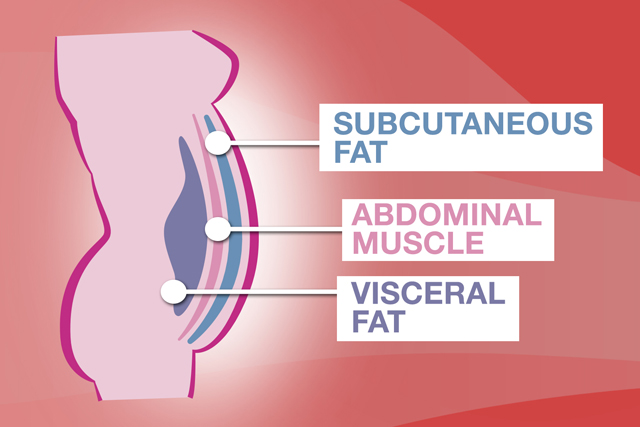There is no shortage of advertised products such as “the six pack abs diet plan”, “the six pack abs workout”, or “six pack abs fast in 30 days”. The truth is that each of us, male or female, prefers to look good shirtless. A flabby bulge around the waist can ruin our appearances even when wearing a shirt or a blouse. You may argue that this concern is based purely on vanity. In “Science on Six-Pack-Abs”, I show it’s not so. Our front abdominal muscles, technically known as rectus abdominis, keep our internal organs safe, as well as aiding in digestion and in breathing. Here’s an illustration:
Furthermore, there is scientific evidence that belly fat deposits are hazardous to human health. science on six-pack-abs begins with an assessment of scientific research pertaining to alleged belly fat risks:
Does belly fat cause cardiovascular disease (Science on Six-Pack-Abs)?
The medical community has long maintained that belly fat, especially deep “visceral” fat which surrounds our internal organs, is extremely unhealthful and can contribute to the atherosclerosis leading to cardiovascular disease (C.D.). However, the vast majority of published research has demonstrated an association only between visceral fat deposits and CD. In other words, they have not demonstrated that belly fat deposits actually cause CD. Most studies leave open the possibility that both conditions are merely symptomatic of another underlying metabolic one. A frequently referenced example of this is “Effect of potentially modifiable risk associated with myocardial infarction in 52countries (the INTERHEART study): case control study” by S. Yusuf et al. and published in The Lancet , Sept. 2004, vol. 364. Based on analysis of data from a group of 15,152 myocardial infarction (M.I.) patients and a control group of 14,820 subjects, authors claim that the odds of abdominal obesity occurring in M.I. patients are significantly heightened by 12%. Note they did not conclude that being abdominally obese increases ones M.I. odds by 12%. In other words, this study does not actually prove that abdominal obesity is causal for M.I. Consequently, Spanking FIT felt obligated to perform an extensive literature search to identify serious studies, if any, which support the causality hypothesis specifically. I uncovered only a couple:
(1) “Visceral Adipose Tissue Inflammation Accelerates Atherosclerosis in Apolipoprotein E-deficient mice” by M. Ohman et al. published in Circulation, Feb. 2008, 117(6).
Because invasive experimentation with humans is generally considered socially unacceptable, researchers in this study attempted to demonstrate causality using mice which were genetically-engineered to be deficient in apolipoprotein E (ApoE). ApoE is a protein which mediates cholesterol metabolism. Its absence makes animals prone to development of atherosclerosis. Groups of these mice received either (1) transplants of visceral fat, (2) transplants of subcutaneous fat, or (3) a sham operation whereby no fat was actually transplanted into them. The latter served as placebo group in the experiment. Researchers reported that after ten weeks, plasma levels of monocyte chemo attractant protein-1 (MCP-1) were significantly elevated in mice with visceral fat transplants compared to the subcutaneous fat transplant group. MCP-1 was also significantly elevated after a 37 week follow up period in a group of visceral transplants compared with a sham operation group. (The protein MCP-1 is believed to play an important physiological role in development of atherosclerosis plaques by promoting inflammation.)
Consistent with the previous findings, researchers reported that the relative quantity of atherosclerosis in the aortic tree of mice was significantly higher in the same above visceral group versus subcutaneous group. It was also significantly higher in the visceral versus sham operation group.
As meticulously conducted as this study was, it unfortunately suffers from a serious but common flaw in medical data analysis: the use of inappropriate parametric stat tests, in lieu of more appropriate non-parametric ones, given that researchers utilized small sample sizes (n=5,6). See: “2016 Discoveries Made by Spanking FIT“, Dec. 2016 for further discussion of this. Only in the case of their visceral versus subcutaneous data comparison did the authors provide the raw data necessary for Spanking FIT to redo their stat analysis using a more appropriate Mann-Whitney stat test. My independent finding is that the degree of atherosclerosis was, indeed, statistically significantly greater in the visceral versus the subcutaneous group. (Spanking FIT has in the past called on journal editors to require their authors to provide links to raw data in order to make independent analysis possible. So far, no progress appears to have been made by them in adopting this simple suggestion.)
(2) “Visceral fat adipokine secretion is associated with systemic inflammation in obese humans” by Luigi Fontana, et al. published in Diabetes, April 2007; 56(4): 1010-1013.
This study is unique in so far as it addresses the causality question using human subjects. The main research hypothesis is that visceral fat promotes inflammation and atherosclerosis by secreting chemicals called adipokines into the portal circulation that drains it. Adipokines are a variety of cytokine secreted specifically by adipose or fat tissue. Cytokines are small proteins which signal immune system defenses including inflammation. It is postulated that first the portal vein carries blood containing adipokines directly from the gastrointestinal tract to the liver. Next, blood leaves the liver and flows to the heart promoting inflammation and atherosclerosis along the way. Researchers cleverly tested their hypothesis by comparing cytokine concentrations in the portal vein with those of the radial artery, the main artery which supplies blood to the forearm. Their findings: cytokine Interleukin 6 (IL-6) concentration levels were significantly higher in portal vein compared to radial artery of obese subjects. Researchers also demonstrated a strong significant correlation between IL-6 concentrations and C reactive protein (CRP) levels in portal vein. CRP is considered an independent marker of atherosclerosis.
Another unique aspect of this investigation is the suggestion made by researchers that they employed appropriate non-parametric statistical methods in performing their analyses. (As previously mentioned, the vast majority of medical research studies utilize inappropriate parametric ones which caste uncertainty on their findings.) One study limitation acknowledged by study authors was the use of obese subjects only. Consequently, future experiments need to be conducted utilizing subjects possessing varying degrees of abdominal fat with similar comparisons made.
How to safely strive for six-pack-abs
It is clear that step 1 is reduction in belly fat. That’s best achieved through regular aerobic exercise including walking, running, and biking. Next, caloric intake reduction needs to be considered; i.e. dieting.
After this, the standard approach to abdominal muscle development is performing “situps”. There are numerous variations of the latter, including so-called Pilates and fitness ball “crunches”. Many of these are even marketed as “six pack abs workouts” or as a “shortcut to acquiring six pack abs”. Be aware that a possible long term side effect of these activities can be inguinal hernia (common in men) and femoral hernia (more common in women). Upon receiving warning signs such as a pinching or a burning sensation in your groin, you should immediately follow Spanking FIT’s basic steps in preventing groinal injury and inguinal hernia. Hernias often require surgery with a recovery period resulting in inactivity for weeks or months. (God forbid!)
Safety suggestion-try “Yoga Crunches”!
Here’s a safer approach: First, stand against a wall on your toes with your arms extended above the head. Begin by taking a deep breadth. Slowly draw in your stomach muscles as you exhale. Hold for several seconds as long as you feel comfortable. Release and inhale. Next, with hands on hips slowly bend forward, repeating the same procedure as above with regard to breathing and holding your muscles in. Do several sets. They may be performed while watching the T.V. news; or, do them while standing naked in front of the mirror. Remember, moderate vanity is healthy.
If performed regularly, the results are amazing for such a simple set of exercises: a dramatic increase in development of rectus abdominis ( six-pack abs), with greatly decreased risk of hernia, in my opinion. I call these simple, but effective abdominal exercises Yoga Crunches.
For the majority of women and men, achieving “six-pack-abs”or maintaining them later in life may be an elusive goal. Nevertheless, it seems clear from the Science that our concerns about mid-section appearance and accumulations of belly fat are much more than a question of vanity. They may even be a matter of life or death. Thank you very much. Dr. Garrett P.S. For more information regarding exercises that similarly enhance both physical attractiveness and health, you may wish to read “Healthy Body Art for the ‘Boys’ & the ‘Girls’- Venus Dimples”, Spanking FIT, April 2015. Thanks again.
Featured image photo credit (N.F.M. Ben Smith by Terry George):
https://www.flickr.com/photos/30974608@N02/14219705569/in/photolist-
Creative commons: https://creativecommons.org/licenses/by-nc-nd/2.0/
Save




